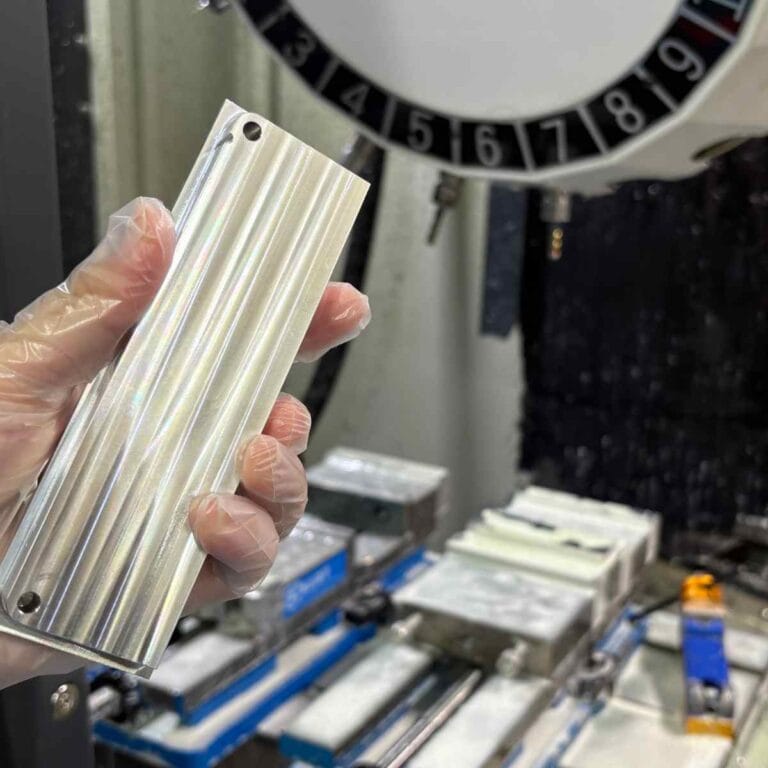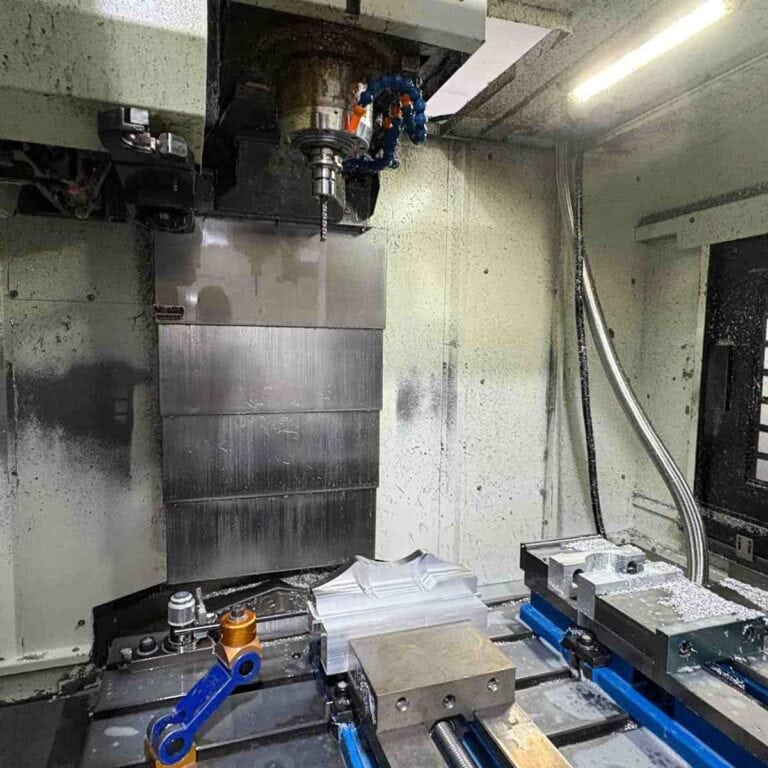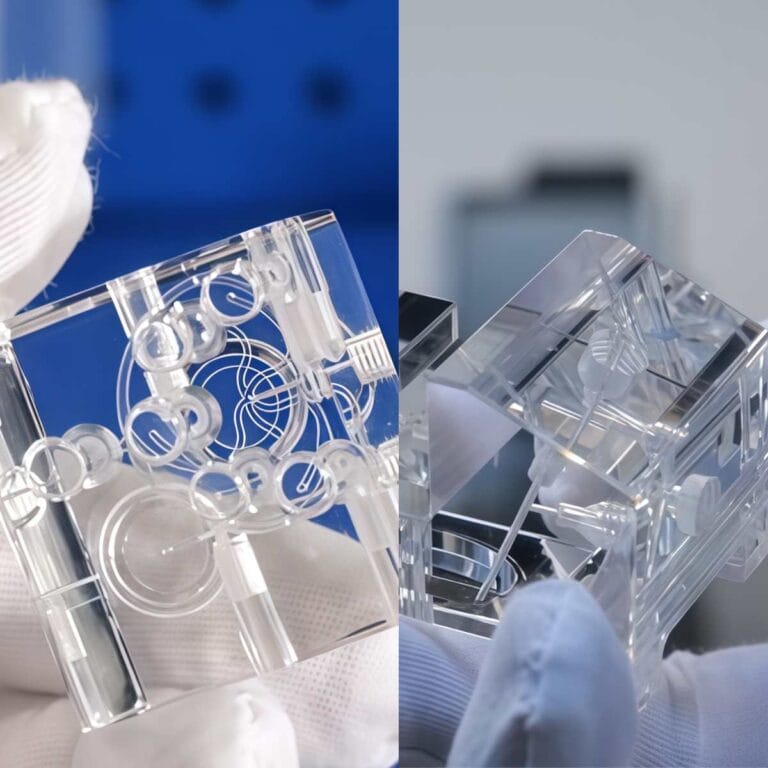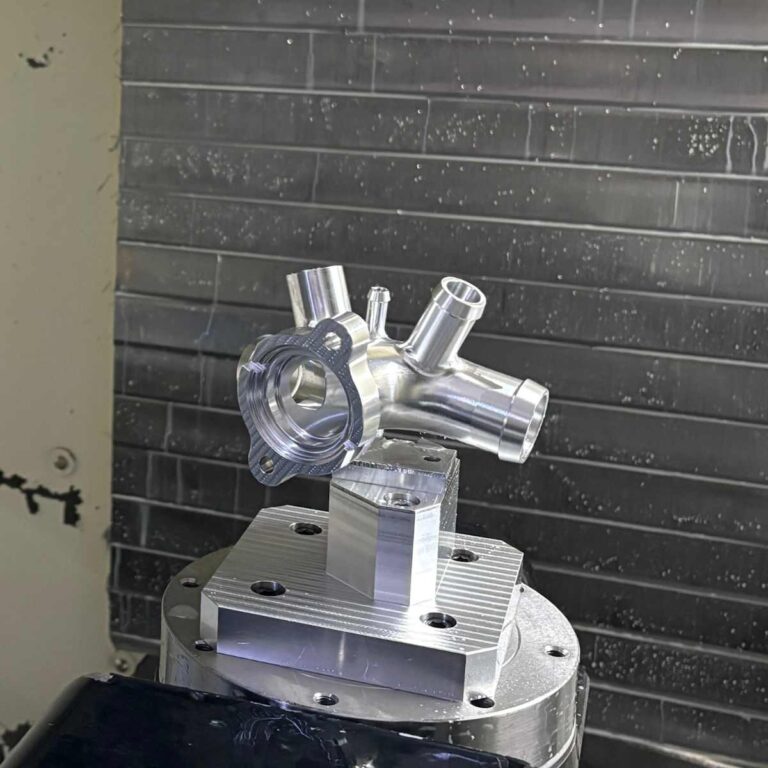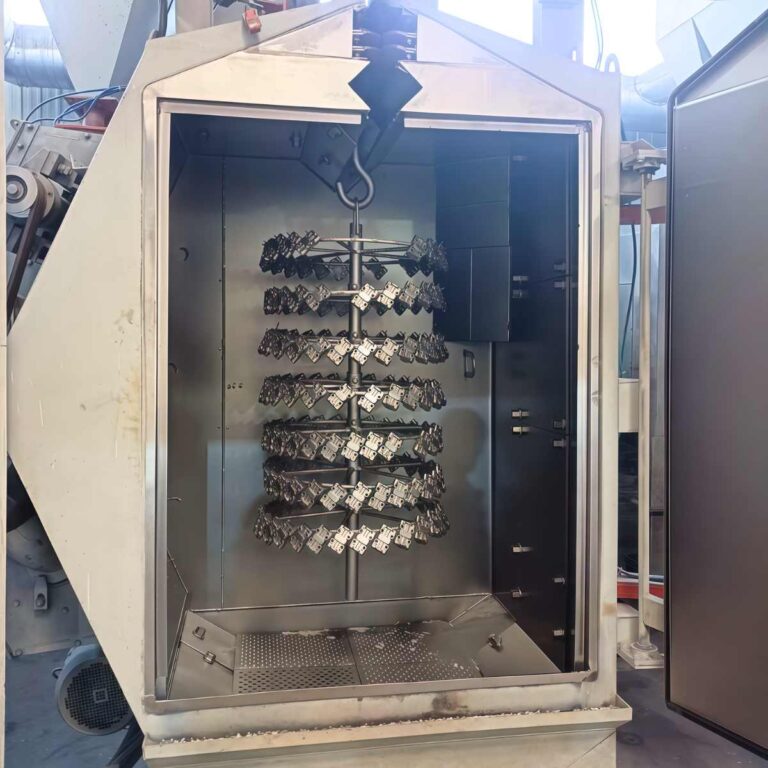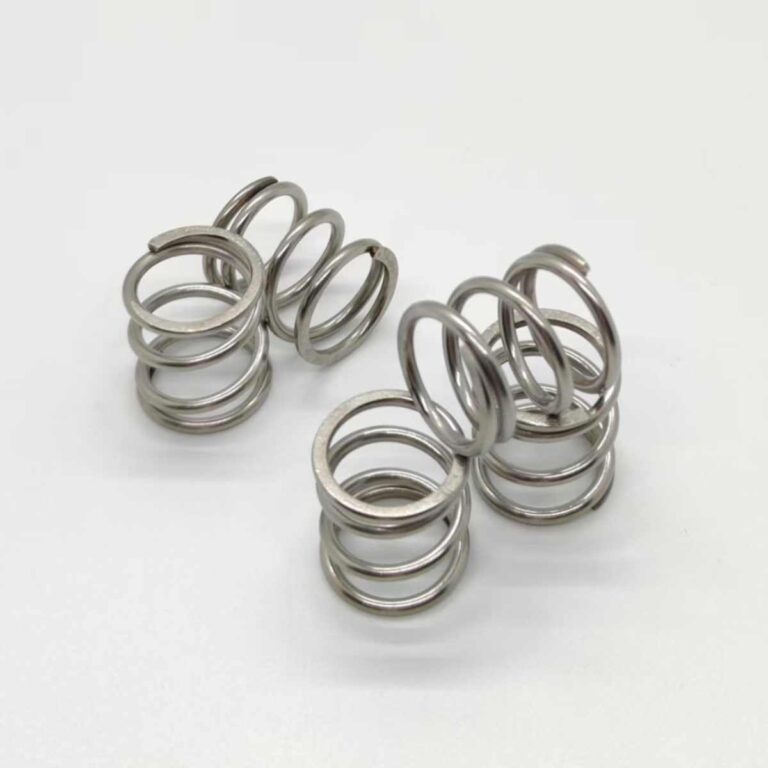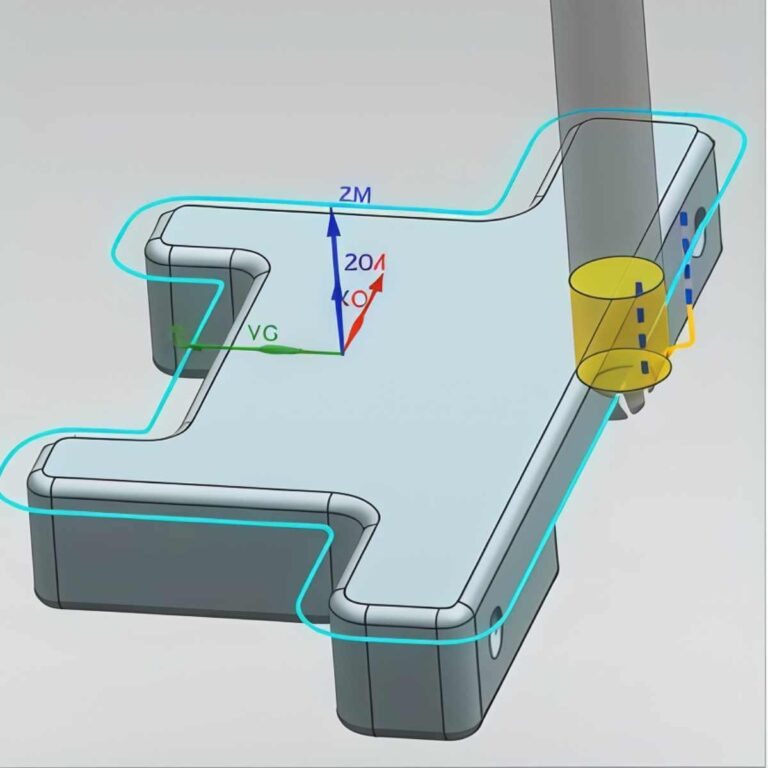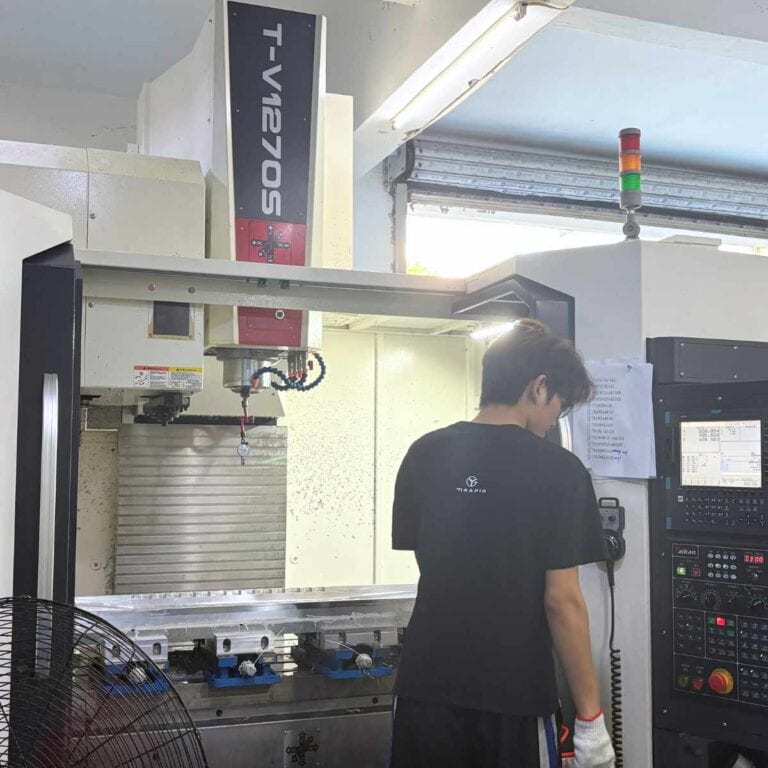Springs are essential mechanical elements used to store energy, absorb shock, and control movement across countless products. Understanding the types of springs and applications helps engineers choose the right design, improve performance, and ensure reliability in real-world conditions.
What is Springs
Springs are fundamental mechanical components designed to store, absorb, and release energy through elastic deformation. Used for centuries—from early clocks to modern automotive suspension—they enable controlled motion, shock absorption, and force management across countless engineering applications.
Get 20% offf
Your First Order
Content — Explanation & Engineering Analysis
A spring is a mechanical device that deforms when force is applied and returns to its original shape once the force is removed. This elastic behavior follows Hooke’s Law, which states that the restoring force is proportional to the displacement (F = kx), as long as the spring remains within its elastic limit. This simple principle allows springs to function as energy-storage devices, vibration dampers, force regulators, and motion stabilizers.
Historical Background & Origin
The earliest known spring mechanisms date back to 14th-century spring-driven clocks, where coiled metal strips provided stored energy to drive gears. As metalworking advanced during the Industrial Revolution, springs evolved into more precise, durable components used in firearms, door latches, carriages, and later automobiles. Today, their applications span electronics, aerospace, machinery, and medical devices.
Material Composition & Properties
Modern springs are typically made from materials with high elasticity and fatigue resistance, including:
High-carbon steel(e.g., 65Mn steel)
Alloy steels(e.g., chrome-silicon, chrome-vanadium)
Stainless steel(304, 316 for corrosion resistance)
Copper alloys(beryllium copper for electrical applications)
Titanium alloys(for high strength-to-weight requirements)
These materials offer excellent tensile strength (often 1000–1800 MPa), allowing springs to endure repeated load cycles without permanent deformation.
Engineering Insight & Real Examples
In CNC machining and prototyping projects handled by TiRapid, springs often appear in:
Automotive prototypes:suspension coil springs, valve springs
Consumer electronics:button mechanisms, battery contacts
Precision devices:medical instruments, locking assemblies
Industrial equipment:vibration isolators, clamping systems
For example, when we manufactured a precision torsion spring for a customer’s hinge mechanism, a tolerance of ±0.03 mm for wire diameter was required to maintain consistent torque output, highlighting how small dimensional deviations can affect spring performance.
Main types of springs
Springs come in many structural forms, each engineered to deliver a specific force response—compression, tension, torque, or constant force. Understanding these categories helps designers choose the right spring for load requirements, installation space, fatigue life, and manufacturing method. Below are the four major spring families used across mechanical, automotive, aerospace, medical, and consumer-product applications.
Category 1: Helical Springs (Coil Springs)
Compression Springs
Compression springs are open-coil helical springs designed to resist axial compression. They deliver force when the coils are pushed together.
Common features and notes:
Manufactured from round, square, or rectangular wire
Designs: straight cylindrical, conical, barrel-shaped, variable-pitch
Applications: pens, valves, shock absorbers, automotive suspensions
Extension Springs
Extension springs operate with closed coils that stretch under load. They store energy when pulled apart and return to their original length once released.
Technical points:
Include hooks, loops, or custom end forms
Preload is often built into the design
Applications: garage doors, levers, agricultural equipment
Torsion Springs
Torsion springs produce torque by twisting their ends around a central axis.
Features:
Can be single-torsion or double-torsion
Torque increases proportionally with angle of rotation
Applications: hinges, clips, automotive trunk systems, machinery mechanisms
Spiral Springs
Spiral springs are made by winding a flat strip of metal into a tight spiral.
Key characteristics:
Stores and releases energy at a near-constant rate
Offers high torque in compact spaces
Applications: clocks, timers, retractable cables, recoil starters
Category 2: Leaf Springs
Leaf springs are long, flat steel plates stacked or shaped for controlled flex. They support large loads with minimal vertical space.
Elliptical, Semi-Elliptical, Quarter, Three-Quarter, and Transverse
Elliptical leaf springs: Two semi-elliptical sections joined together to form an oval shape; historically used in older vehicles.
Semi-elliptical: Most common automotive suspension spring; stacked leaves with a master leaf at the top.
Quarter elliptical: Cantilever design fixed at one end; used in early automobiles.
Three-quarter elliptical: Combination of quarter and semi-elliptical for heavier loads.
Transverse leaf springs: Mounted across vehicle width; lightweight but prone to roll in high-load conditions.
Applications: trucks, trailers, railcars, off-road vehicles.
Category 3: Disk Springs (Belleville Springs)
Disk springs are washer-shaped springs designed to handle very high loads in limited axial space.
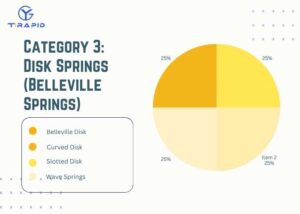
Belleville Disk
Conical-shaped washer that compresses under load
Ideal for preload, vibration control, heavy-duty clamping
Used in bolted joints, turbines, and pressure valves
Curved Disk
Crescent-shaped washer providing light loads
Excellent for maintaining tension in assemblies exposed to vibration
Common in small motors, fasteners, and electronics
Slotted Disk
Radial slots increase deflection while reducing stiffness
Suitable for clutches, transmissions, overload protection systems
Wave Springs
Multiple waves around the circumference
Provide precise loads with shorter working height
Used in bearings, medical devices, compressors
Category 4: Special Springs
Constant Force Springs
Deliver nearly constant force throughout the entire deflection range
Made from pre-stressed rolled strip
Applications: retractable cords, medical devices, counterbalance systems.
Gas Springs
Use compressed gas to provide damping or lifting force
Applications: automotive hoods, furniture hinges, industrial lids
Machined Springs
CNC-machined from solid bar stock for extreme precision
Customizable for multi-axis loads
Used in aerospace, defense, and high-reliability mechanisms
Flat Springs
Made from stamped sheet metal; lightweight with fast response
Common in battery contacts, clips, electrical components
Materials Used for Springs
The performance, durability, and cost of different types of springs and applications depend heavily on the material selected. Each spring material offers unique properties—strength, elasticity, corrosion resistance, or lightweight performance—making material choice crucial for engineering design.
| Material Type | Key Properties | Advantages | Typical Applications |
| Stainless Steel | High corrosion resistance, strong elasticity, excellent fatigue strength | Performs well in harsh or high-humidity environments | Medical devices, food equipment, outdoor mechanisms |
| Alloy Steel (low-alloy, oil-tempered, bainite-hardened) | High tensile strength, heat resistance, excellent fatigue life | Best for heavy loads and high-stress conditions | Automotive suspension, industrial machinery |
| Copper Alloys (e.g., Beryllium Copper) | High electrical and thermal conductivity, good formability | Non-magnetic, excellent precision forming | Sensors, electronics, measurement devices |
| Titanium Alloy | Lightweight with high strength-to-weight ratio, excellent corrosion resistance | Ideal for weight-sensitive or high-performance systems | Aerospace springs, racing components, medical implants |
| Rubber / Urethane | High flexibility, non-conductive, vibration-damping | Safe, silent operation | Shock-absorbing pads, non-coil springs, vibration control |
| Composite Materials (glass-fiber reinforced) | High specific strength, customizable stiffness, corrosion-free | Lightweight alternative to steel springs | Advanced automotive systems, sporting goods |
How Springs Are Manufactured
Manufacturing a spring involves multiple controlled processes that determine its strength, elasticity, fatigue life, and overall performance. Although spring designs vary widely, most types follow a similar workflow—from winding to heat treatment and finishing—to ensure stable mechanical properties and long-term durability.
Winding / Coiling
Spring production begins by feeding straightened wire into a CNC coiler or mechanical spring-forming machine. The wire is wound into helical shapes for compression, extension, and torsion springs, or formed into more complex geometries using multi-axis wire formers. Coiling parameters such as pitch, diameter, and coil direction directly influence stiffness and load capacity. For specialty shapes, CNC wire benders create precise bends and radii used in flat springs and custom wire forms.
Heat Treating / Stress Relieving
After forming, springs undergo heat treatment to relieve internal stresses produced during coiling. Typical stress-relief temperatures range from 250–480°C depending on the alloy (e.g., music wire, stainless steel, Inconel). Proper heat treatment improves elastic recovery, reduces the risk of creep or deformation, and significantly enhances fatigue life. Some high-performance springs may require multiple heating cycles.
Grinding / End Finishing
For compression springs, the end faces are ground flat to ensure stable vertical loading and uniform force distribution. CNC end-grinders remove excess material and achieve precise perpendicularity, improving performance in automotive suspensions, valves, and high-precision mechanical assemblies.
Coating & Surface Finishing
Surface treatments protect springs from corrosion, wear, and fatigue damage. Common finishes include electroplating (zinc, nickel, copper), powder coating, anodizing (for aluminum), or shot-peening for high-cycle fatigue resistance. Shot-peening is particularly effective, creating compressive residual stresses that extend spring service life by up to 50%.
Precision Machining for Specialty Springs
Some specialized springs—such as machined springs, wave springs, and custom high-load components—are produced through CNC milling and turning instead of coiling. This method ensures exceptional dimensional accuracy, consistent spring rates, and the ability to integrate complex features into a single monolithic part, making them ideal for aerospace, medical devices, and precision instruments.
Functions & Benefits of Springs
Springs play a critical role in mechanical systems by managing force, movement, and energy with remarkable efficiency. Whether used in consumer electronics, vehicles, industrial machinery, or precision devices, springs enhance performance by absorbing shock, storing energy, stabilizing components, and enabling controlled motion. Understanding these core functions helps engineers select the right spring type for reliable, long-lasting product design.

Shock Absorption
Springs compress under sudden loads to absorb shock, protecting surrounding components from impact damage. Automotive suspension systems, machinery mounts, and handheld devices rely on this property to maintain stability and extend service life.
Energy Storage & Release
A spring can store mechanical energy when deformed and release it predictably when unloaded. Spiral and torsion springs are often used where continuous or regulated energy output is needed, such as in mechanical clocks, retractable mechanisms, and reel systems.
Motion Control
Springs regulate movement by resisting force in a linear or rotational direction. Torsion springs in hinges, valve springs in engines, and precision springs in robotics demonstrate how springs help maintain precise and repeatable motion.
Vibration Damping
By oscillating in response to vibration, springs minimize resonance and prevent structural fatigue. They are commonly used in motors, compressors, and electronic assemblies to reduce noise, extend lifespan, and improve performance.
Join & Return Mechanism
Springs facilitate connection and retraction between linked components. Examples include push-button systems, latching devices, garage door mechanisms, and weighing machines—where springs ensure reliable return motion and consistent functionality.
Common Failure Causes & How to Prevent Them
Spring failure can lead to downtime, safety risks, and costly equipment damage. Understanding the major causes of failure—and how to prevent them—helps designers specify the right spring type, material, and manufacturing process for demanding applications.
Stress Overload
Excessive force beyond the spring’s elastic limit causes permanent deformation or fracture. Proper load calculations, safety factors, and fatigue analysis are essential to ensure long-term performance.
Wrong Material Selection
Selecting a material that cannot withstand the operational load, temperature, or corrosion environment leads to premature failure. Using stainless steel, alloy steel, copper alloys, or titanium based on real-world conditions is essential for durability.
Poor Finishing
Inadequate surface finishing accelerates wear, corrosion, and crack formation. Techniques like shot-peening, plating, powder coating, and polishing help increase fatigue life and resist environmental degradation.
Temperature Mismatch
Springs exposed to temperatures above or below their material limits lose elasticity, suffer creep, or crack. High-temperature alloys or ceramics should be used when operating conditions exceed 200–300°C.
Improper Manufacturing Process
Errors in winding, heat treating, or grinding can introduce internal stresses or geometric inconsistencies. Precise control of process parameters ensures consistent performance and reduces the risk of structural failure.
How to Choose the Right Spring
Choosing the right spring starts with understanding how it will work in your mechanism: the type of load, required travel, expected life, and operating environment all influence the ideal spring type, material, and cost level. A good design balances performance, manufacturability, and budget.
Key factors to consider:
Load type
Decide whether the spring works in compression, extension, torsion, or as a constant-force element. Define minimum/maximum load, whether the load is static, dynamic, or impact, and how quickly it is applied.
Displacement requirements
Determine the required deflection (stroke), spring rate (N/mm), and available installation space. Check that the spring can operate within its elastic range without reaching solid height or permanent set.
Life cycle and fatigue
Estimate how many cycles the spring must survive (hundreds, thousands, or millions). High-cycle applications (suspension, switches, valves) often require lower working stress, higher-quality materials, and stricter process control.
Material properties
Select materials based on strength, fatigue resistance, corrosion resistance, and weight: stainless and alloy steels for high strength, copper alloys for conductivity, titanium for lightweight, elastomers for quiet, non-metallic behavior.
Cost vs performance
Match the spring design to your budget: standard catalog springs and simple coil designs cost less; special geometries, tight tolerances, exotic materials, and complex forming or grinding increase price but may be necessary for critical functions.
Environmental conditions
Consider operating temperature, humidity, exposure to chemicals, and vibration. High-temperature or corrosive environments may require stainless, nickel alloys, coatings, or surface treatments such as shot peening and plating to ensure long-term reliability.
FAQs
What Is The Difference Between A Helical Spring And A Spiral Spring?
A helical spring stores energy through axial compression or tension, using a round wire wound into a cylindrical coil. It provides linear force and is common in automotive suspensions and mechanical devices. A spiral spring, however, uses a flat strip wound into a spiral and delivers torque at a constant rate. I typically use helical springs for load-bearing tasks and spiral springs for clocks, reels, and return mechanisms due to their rotary energy output.
Which Type Of Spring Is Best?
The “best” spring depends entirely on application requirements. For axial load and shock absorption, I prefer compression helical springs due to their durability and wide load range. For torque, torsion or spiral springs perform better, offering precise angular response. In high-load, limited-space environments, disk (Belleville) springs provide exceptional force density. Each spring excels when matched with correct load, displacement, and lifecycle needs.
What Metal Makes The Best Spring?
From my engineering experience, high-carbon steel and alloy steels (such as 65Mn and chrome-silicon steel) provide the best combination of strength, elasticity, and fatigue resistance. Stainless steel 302/316 works best for corrosion-prone environments. For high conductivity and anti-sparking needs, beryllium copper is ideal. Titanium alloys deliver top performance when weight reduction is essential, offering 40% lower density compared to steel with excellent fatigue life.
What Are The Most Common Types Of Springs?
The most common springs are compression, extension, torsion, coil (helical), leaf, disk (Belleville), constant-force, and spiral springs. In my projects, compression springs account for nearly 40% of use cases due to their versatility, while torsion springs dominate hinge and rotational systems. Disk springs are preferred in compact high-load assemblies. Each type addresses specific mechanical functions such as shock absorption, torque delivery, or vibration control.
What Materials Are Springs Made Of?
Springs are primarily made from high-carbon steels, alloy steels, stainless steels, copper alloys, titanium, and composite materials. I select carbon steels for general strength, stainless steels for corrosion resistance, copper alloys for electrical applications, and titanium when weight savings are critical. Modern designs increasingly use composite materials for high-fatigue environments due to their excellent strength-to-weight ratio.
Conclusion
Choosing the right spring begins with understanding how each type behaves under load, motion, and environmental conditions. From helical and leaf springs to disk and specialty designs, every spring offers unique advantages for force control, shock absorption, and energy storage. By selecting the proper geometry, material, and manufacturing method, engineers can ensure long-lasting performance and efficiency across automotive, industrial, medical, and consumer applications. A well-matched spring isn’t just a component—it’s the key to reliable, predictable mechanical function.

